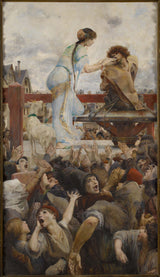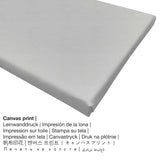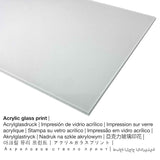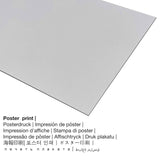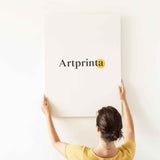Luc-Olivier Merson, 1903 - akwa akwa maka (Nwanyị anyị nke Paris) - mbipụta nka mara mma.
Ụtụ gụnyere. Mbupu gbakọrọ na ndenye ọpụpụ.
Kedu ihe kacha amasị gị?
In the product dropdown selection you can select your individual material and size. Select your preferred size and material among the subsequent preferences:
- Mbipụta enyo acrylic: The acrylic glass print, often referred to as a fine art print on plexiglass, makes your favorite original work of art into amazing décor and is a distinct alternative to canvas and dibond fine art replicas. With an acrylic glass art print sharp contrasts and small artwork details will be more exposed because of the precise tonal gradation. The acrylic glass protects your selected art replica against light and heat for between 40-60 years.
- Poster (akwa akwa akwa): Our poster is a UV printed cotton canvas paper with a slightly roughened surface texture. Please bear in mind, that depending on the absolute size of the poster we add a white margin 2-6cm around the artwork to facilitate the framing with your custom frame.
- Mbipụta kwaaji: The printed canvas applied on a wooden frame. Your canvas print of your favorite work of art will allow you to transform your own into a large size work of art as you would see in a gallery. How do I hang a canvas on my wall? A canvas print has the advantage of being low in weight, which means that it is easy and straightforward to hang your Canvas print without the support of extra wall-mounts. A canvas print is suited for any type of wall.
- Mbipụta ọla (aluminium dibbond): An Aluminium Dibond print is a material with a true effect of depth - for a modern look and a non-reflective surface. A direct Direct Print on Aluminum Dibond is your excellent introduction to art replicas on aluminum. For your Print On Aluminum Dibond, we print your favorite work of art on the aluminium white-primed surface.
Legal disclaimer: We try our utmost in order to depict our products as clearly as possible and to display them visually on the respective product detail pages. Nonetheless, some tone of the printed materials, as well as the print result might differ slightly from the image on the screen. Depending on the screen settings and the quality of the surface, not all color pigments will be printed 100% realistically. Bearing in mind that all our art prints are processed and printed manually, there may also be slight variations in the motif's exact position and the size.
Nkọwa site na webụsaịtị ihe ngosi nka (© Nwebiisinka - Maison de Victor Hugo - Ụlọ Hauteville - Maison de Victor Hugo - Ụlọ Hauteville)
The painting illustrates the main point of the episode being chapter IV of Book VI of Victor Hugo's novel "Notre Dame de Paris", "A tear for a drop of water", which gives the painting its title while synthesizing more elements of récit.Alors Quasimodo is tied to the pillory of the Greve in mockery and insults of the crowd ( "a thousand other insults rained down, and the jeers and imprecations, and laughter, and the stones here and there. "), he claims several times" to drink. " So Esmeralda, accompanied by her goat Djali, through the crowd, up the ladder of the pillory: "She went, without a word, the patient writhed vainly to escape her, and detaching a gourd from her belt, she gently brought to the parched lips of misérable.Alors in that eye hitherto dry and burned if they saw a big tear rolling slowly fell along the deformed face and long contracted with despair. It was the first perhaps the unfortunate had ever paid. "But the time is shown next, the text accompanying the etching of the first version of the work, published in the National Edition of the works of Victor Hugo, in 1889:" But he forgot to drink. The Egyptian made her pout forward and leaned smiling neck to the tusked month of Quasimodo. It took a long. His thirst was burning. "
This painting is part of orders placed by Paul Meurice living artists for the museum's opening in 1903. Luc-Olivier Merson had shown two volumes, published in 1889, of "Our Lady of Paris" for National Edition (Emile Testard and Co., publishers) that Paul supervised, especially for illustration. Paul Meurice as he deals directly with the artist without using Arsène Alexandre Fortuné Méaulle or sometimes serve as intermediaries for some commands (this will be the case for the control of "Burgraves" to Rochegrosse ). Alas, the letters to Merson Meurice, kept in the archives of the museum are not dated and therefore give no indication of the progress and completion of tableau.On may think it is this work for national Edition which guided his choice and that of the artist for a subject taken from the novel and perhaps also for the composition that incorporates part of the engravings inset of the first volume, introducing chapter IV of book VI, which gives its name to the painting: "a tear for a drop of water." This etching provides the base of the upper part of the painting, while undergoing certain transformations: the houses of his background partially modified due to the addition of the wooden railing, the pillory is redrawn, links appear for Quasimodo will hold more dramatic, the goat is moved to the left to the dynamics of the composition. The crowd, far away and barely visible in the background of the engraving is close and most importantly, it will give the new and lively pattern of the first plan.La new composition is carefully structured: starting from the dog's head at the bottom the canvas, the read line continues with the man's arm to the cap seen from the back, reinforced by twisting the child's gesture in the red cap and grip the man's face long black cap - the only one who looks at us that this cap student might call Jehan Frollo, mentioned in the story - while the hands in megaphone of his neighbor scarlet cap direct, along with his cry, look toward the forest hands that lead to the edge of the platform of stones where the goat, on a beautiful curve returns the line to the belt of the gypsy, the gesture of his arm to reach the visage of Quasimodo whose gaze leads us finally to the face Esmeralda. Thus it is carried bestiality angélisme.Toute to the composition, in fact based on a set of contrasts between the top and bottom; between saturation and empty; between the violent agitation of the crowd and the serenity of the hero; between the ugliness of Quasimodo and Esmeralda grace. This desire of antithesis not only meets the spirit of Victor Hugo but also important moment for the novel is the episode in which revives the fate of two children exchanged at birth where born love of Quasimodo in response to Esmeralda gesture that is - and only - affirmation of freedom and that compassion.Paul Meurice, text and guardian of the spirit, was closely following his orders probably by his conversations with Merson played a role in the design and details of the painting. The only accurate record of its intervention concerns Esmeralda, just to introduce more contrast and complexity in his face, and attach sensuality otherworldliness. Indeed, in a letter Merson replied: "I made the edits you kindly ask. I glittery dress, enriched scarf, put his arm bracelets, gold belt and increased hair sequins. There is only one thing I could do is to Esmeralda in short skirt. When you shall see the table you will understand immediately that the provision of the composition did not allow me to clear the legs. Despite this the dancer lost her virginity character. It is certainly more showman than before and I hope that the changes I made helping her, she will give a better impression to the character standpoint.
Esmeralda (edemede edemede); Quasimodo (agwa edemede)
Notre Dame de Paris (V.Hugo)
Background information on the artwork by Luc-Olivier Merson
"A tear drop for (Our Lady of Paris)" is a masterpiece by the artist Luc-Olivier Merson in 1903. Ihe gafere 110 year old original had the following size: Height: 195 cm, Width: 110 cm and was painted on the medium Mmanụ, Canvas (ihe). Signature - Bottom left "Luc-Olivier Merson 1903" was the masterpiece's inscription. It is in the the Maison de Victor Hugo - Ụlọ Hauteville nchịkọta dijitalụ. Site n'ikike nke - Maison de Victor Hugo - Ụlọ Hauteville (ọha na eze).Ebe E Si Nweta nke ihe osise:. E wezụga nke ahụ, nhazi ahụ dị n'ime Eserese usoro ma nwee oke nke 9: 16, nke na-egosi na ogologo ya dị 45% dị mkpụmkpụ karịa obosara.
Data ndabere na ọrụ nka
| Aha nka: | "A tear drop for (Our Lady of Paris)" |
| Nhazi: | sere |
| Otu sara mbara: | nkà nke oge a |
| Century: | 20th narị afọ |
| Emepụtara n'afọ: | 1903 |
| Afọ nka: | ihe karịrị 110 afọ |
| Usoro nka izizi: | Mmanụ, Canvas (ihe) |
| Akụkụ nke ihe osise izizi: | Ogologo: 195 cm, obosara: 110 cm |
| Ederede ihe osise izizi: | Signature - Bottom left "Luc-Olivier Merson 1903" |
| Ụlọ ihe ngosi nka: | Maison de Victor Hugo - Ụlọ Hauteville |
| Ebe ebe ngosi nka: | Paris, France |
| Weebụsaịtị ihe ngosi nka: | Maison de Victor Hugo - Ụlọ Hauteville |
| Akwụkwọ ikike nka: | ngalaba ọha |
| Site n'aka: | Maison de Victor Hugo - Ụlọ Hauteville |
Banyere edemede a
| Bipụta ngwaahịa: | ọrụ mgbidi |
| Usoro mmeputakwa: | mmeputakwa n'ụdị dijitalụ |
| Usoro mmepụta: | Mbipụta UV ozugbo (mbipụta dijitalụ) |
| Nlụpụta: | Germany |
| Ụdị ngwaahịa: | mmepụta ihe na-achọ |
| Eji ngwaahịa emebere: | nka mgbidi, mma mgbidi |
| Nhazi: | usoro eserese |
| Ụdị anya: | 9: 16 - ( Ogologo: obosara) |
| Mmetụta akụkụ: | ogologo bụ 45% mkpụmkpụ karịa obosara |
| Akụrụngwa ị nwere ike ịhọrọ site na: | Mbipụta iko acrylic (nke nwere ezigbo mkpuchi iko), mbipụta kanvas, mbipụta ọla (aluminium dibond), mbipụta akwụkwọ mmado (akwụkwọ kwaaji) |
| Mbipụta kanvas (akwa akwa n'elu etiti ihe ndọtị) ụdị nha dị iche iche: | 50x90cm - 20x35", 100x180cm - 39x71" |
| Mbipụta iko acrylic (nke nwere ezigbo mkpuchi iko): | 50x90cm - 20x35", 100x180cm - 39x71" |
| Nhọrọ nha nke akwụkwọ mmado (akwụkwọ kwaaji): | 50x90cm - 20x35" |
| Nhọrọ nha nha nke Dibond (ihe alumnium): | 50x90cm - 20x35" |
| ụba: | ngwaahịa anaghị emebi emebi |
Tebụl nkọwa omenkà
| Ihe nkiri: | Luc-Olivier Merson |
| Ọrụ: | onye na-ese ihe |
| nhazi ọkwa: | omenkà nke oge a |
| Oge ndu: | 74 afọ |
| Afọ ọmụmụ: | 1846 |
| Obodo ọmụmụ: | Paris |
| Nwuru: | 1920 |
© Copyright - ikike ọgụgụ isi nke | Artprinta (www.artprinta.com)

